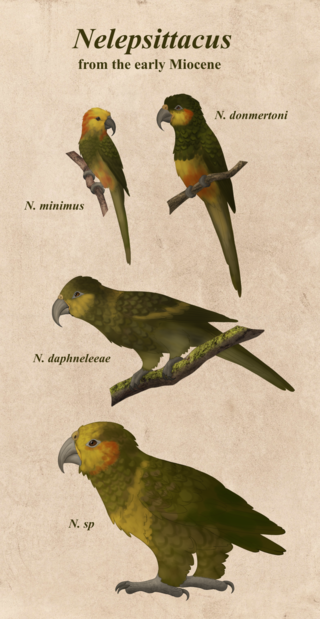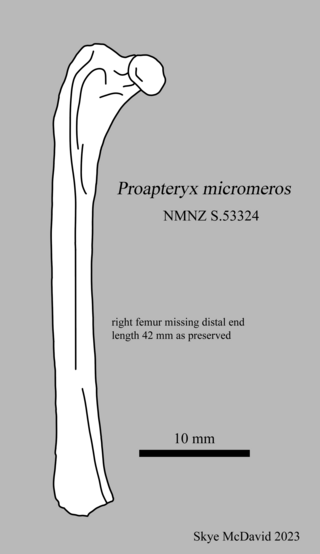Related Research Articles

Owlet-nightjars are small crepuscular birds related to the nightjars and frogmouths. Most are native to New Guinea, but some species extend to Australia, the Moluccas, and New Caledonia. A flightless species from New Zealand is extinct. There is a single monotypic family Aegothelidae with the genus Aegotheles.

St Bathans, formerly named Dunstan Creek, is a former gold and coal mining town in Central Otago, New Zealand. The settlement was a centre of the Otago Gold Rush, but mining has since long ceased. It is now largely a holiday retreat due to the preservation of many of its historic buildings.

The biodiversity of New Zealand, a large island country located in the south-western Pacific Ocean, is varied and distinctive. The species of New Zealand accumulated over many millions of years as lineages evolved in the local circumstances. New Zealand's pre-human biodiversity exhibited high levels of species endemism, but has experienced episodes of biological turnover. Global extinction approximately 65 Ma resulted in the loss of fauna such as non-avian dinosaurs, pterosaurs and marine reptiles e.g. mosasaurs, elasmosaurs and plesiosaurs. The ancient fauna is not well known, but at least one species of terrestrial mammal existed in New Zealand around 19 Ma. For at least several million years before the arrival of human and commensal species, the islands had no terrestrial mammals except for bats and seals, the main component of the terrestrial fauna being insects and birds. As recently as the 14th century a component has been introduced by humans, including many terrestrial mammals.

Mystacinidae is a family of unusual bats, the New Zealand short-tailed bats. There is one living genus, Mystacina, with two species, one of which could have possibly become extinct in the 1960s. They are medium-sized bats, about 6 centimetres (2.4 in) in length, with grey, velvety fur.
Icarops is an extinct, possibly paraphyletic genus of mystacine bat with three described species. The genus is known from fossils found at Riversleigh, north-western Queensland, Bullock Creek, Northern Territory, and Lake Ngapakaldi to Lake Palankarinna Fossil Area South Australia Australia. The fossils date from the late Oligocene to early Miocene.

Prior to human settlement, the mammals of New Zealand consisted entirely of several species of bat and several dozen marine mammal species. Far earlier, during the Miocene, at least one "archaic" terrestrial mammal species is known to have existed, the Saint Bathans mammal. The Māori brought the kurī and kiore in about 1250 CE, and Europeans from 1769 onwards brought the pig, mice, two additional species of rats, weasels, stoats, ferrets and possums and many other species, some of which cause conservation problems for indigenous species.

Nelepsittacus is a genus of extinct New Zealand parrots that is closely related to the genus Nestor. It consists of four species, of which three have been named so far. The species are all known from the early Miocene Saint Bathans Fauna from the Lower Bannockburn Formation in Otago in New Zealand.

Proapteryx micromeros is an extinct kiwi known from the 16–19 million-year-old early Miocene sediments of the St Bathans Fauna of Otago, New Zealand.
Matuku otagoense, also referred to as the Saint Bathans heron, is an extinct genus and species of heron from the Early Miocene of New Zealand. It was described from fossil material collected in 2007 from the Saint Bathans fauna of the Bannockburn Formation in Otago, South Island. It was a contemporary of the much smaller Saint Bathans bittern, remains of which have been found in the same sediments. The genus name matuku is a Māori-language word meaning “heron” or "bittern". The specific epithet is a latinisation of the name of the Otago region where the descriptive material was collected.
Rupephaps taketake, also referred to as the Saint Bathans pigeon, is an extinct species of pigeon from the Miocene of New Zealand. It is the first species of columbid to be described from pre-Pliocene fossil deposits in the Australasian region.

The St Bathans fauna is found in the lower Bannockburn Formation of the Manuherikia Group of Central Otago, in the South Island of New Zealand. It comprises a suite of fossilised prehistoric animals from the late Early Miocene (Altonian) period, with an age range of 19–16 million years ago.
Manuherikia is a genus of extinct species of ducks from the Miocene of New Zealand. It was described from fossil material of the Saint Bathans Fauna, in the lower Bannockburn Formation of the Manuherikia Group, found by the Manuherikia River in the Central Otago region of the South Island. The genus name comes from the name of the geological formation in which the fossils were found and, ultimately, from the Manuherikia River and its valley.
Miotadorna is a genus of extinct tadornine ducks from the Miocene of New Zealand. It contains two species, M. sanctibathansi, and M. catrionae.

Pikaihao bartlei, also referred to as Bartle's bittern or the Saint Bathans bittern, is a genus and species of prehistoric small bittern from the Early Miocene of New Zealand. It was described in 2013 from fossil material found in the Saint Bathans Fauna of the Bannockburn Formation, at Home Hills Station in the Manuherikia River valley of Otago, South Island. It was a contemporary of the much larger Saint Bathans heron, remains of which have been found in the same sediments. The genus name Pikaihao comes from the Māori pi and kaihao (“fisherman”). The specific epithet honours Sandy Bartle, Curator of Birds at the Museum of New Zealand Te Papa Tongarewa from 1976 to 2009.

The Manuherikia Group is a fluvial-lacustrine sedimentary fill in the Central Otago area of New Zealand, at the site of the prehistoric Lake Manuherikia. The area consists of a valley and ridge topography, with a series of schist-greywacke mountains at roughly ninety degrees to each other. The Manuherika Group occurs in the current basins, and occasionally on the mountains themselves.
Kuiornis indicator is an extinct New Zealand wren (Acanthisittidae) known from the early Miocene St Bathans fauna in Central Otago. It is known from a holotype proximal right tarsometatarsus. Amongst acanthisittids it is most closely related to the living rifleman.
Vulcanops jennyworthyae is an extinct species of bat that lived during the Miocene in New Zealand, a large burrowing microchiropteran that probably ate arthropods and plant material around twenty million years before present. It is the type and only described species of the genus Vulcanops.

Heracles inexpectatus is a giant fossil parrot species from New Zealand, assigned to a monotypic genus Heracles, that lived during the early Miocene approximately 16 to 19 million years ago. The species was described from two tibiotarsus fossils discovered in 2008 at Saint Bathans, Otago, New Zealand. It is believed that the species stood up to 90 cm tall and weighed approximately 7 kg (15 lb). Initial analysis suggests that this parrot is from the order Psittaciformes and from the superfamily Strigopoidea, which consists of three confirmed primitive genera of parrots: Nestor, Strigops (Kākāpō) and the fossil Nelepsittacus. It may have been the ancestor of the kākāpō.

Zealandornis is an extinct genus of zealandornithid bird from the early Miocene Bannockburn Formation of Otago, New Zealand. The genus contains a single species, Zealandornis relictus, known from a distal right humerus.
Notochen, also called the Bannockburn swan, is an extinct genus of anatid bird from the Early Miocene Bannockburn Formation of Otago, New Zealand. The genus contains a single species, Notochen bannockburnensis, known from various fossil material.
References
- 1 2 Worthy, Trevor H.; Tennyson, Alan J. D.; Archer, Michael; Musser, Anne M.; Hand, Suzanne J.; Jones, Craig; Douglas, Barry J.; McNamara, James A.; Beck, Robin M. D. (2006). "Miocene mammal reveals a Mesozoic ghost lineage on insular New Zealand, southwest Pacific". PNAS. 103 (51): 19419–19423. Bibcode:2006PNAS..10319419W. doi: 10.1073/pnas.0605684103 . PMC 1697831 . PMID 17159151.
- ↑ Worthy, Trevor H.; et al. (2013). Miocene fossils show that kiwi (Apteryx, Apterygidae) are probably not phyletic dwarves (PDF). Paleornithological Research 2013, Proceedings of the 8th International Meeting of the Society of Avian Paleontology and Evolution. Retrieved 9 March 2014.
- ↑ Scofield, R. Paul; Worthy, Trevor H. & Tennyson, Alan J.D. (2010). "A heron (Aves: Ardeidae) from the Early Miocene St Bathans Fauna of southern New Zealand." In W.E. Boles & T.H. Worthy. Proceedings of the VII International Meeting of the Society of Avian Paleontology and Evolution. Records of the Australian Museum 62. pp. 89–104. doi : 10.3853/j.0067-1975.62.2010.1542
- ↑ Hand, Suzanne J.; Worthy, Trevor H.; Archer, Michael; Worthy, Jennifer P.; Tennyson, Alan J. D.; Scofield, R. Paul (2013). "Miocene mystacinids (Chiroptera, Noctilionoidea) indicate a long history for endemic bats in New Zealand". Journal of Vertebrate Paleontology. 33 (6): 1442–1448. doi:10.1080/02724634.2013.775950. S2CID 85925160.
- ↑ Hand, Suzanne J.; Beck, Robin M. D.; Archer, Michael; Simmons, Nancy B.; Gunnell, Gregg F.; Scofield, R. Paul; Tennyson, Alan J. D.; De Pietri, Vanesa L.; Salisbury, Steven W.; Worthy, Trevor H. (2018). "A new, large-bodied omnivorous bat (Noctilionoidea: Mystacinidae) reveals lost morphological and ecological diversity since the Miocene in New Zealand". Scientific Reports. 8 (1): 235. Bibcode:2018NatSR...8..235H. doi:10.1038/s41598-017-18403-w. PMC 5762892 . PMID 29321543.




